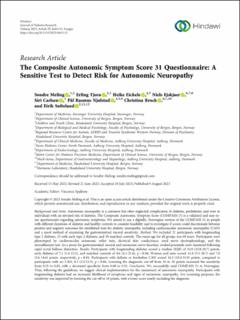| dc.description.abstract | Background and Aims. Autonomic neuropathy is a common but often neglected complication of diabetes, prediabetes, and even in individuals with an elevated risk of diabetes. The Composite Autonomic Symptom Score (COMPASS) 31 is a validated and easy-to- use questionnaire regarding autonomic symptoms. We aimed to use a digitally, Norwegian version of the COMPASS 31 in people with different durations of diabetes and healthy controls to consider feasibility and to investigate if scores could discriminate between positive and negative outcomes for established tests for diabetic neuropathy, including cardiovascular autonomic neuropathy (CAN) and a novel method of examining the gastrointestinal visceral sensitivity. Method. We included 21 participants with longstanding type 2 diabetes, 15 with early type 2 diabetes, and 30 matched controls. The mean age for all groups was 69 years. Participants were phenotyped by cardiovascular autonomic reflex tests, electrical skin conductance, sural nerve electrophysiology, and the monofilament test. As a proxy for gastrointestinal visceral and autonomic nerve function, evoked potentials were measured following rapid rectal balloon distention. Results. Participants with longstanding diabetes scored a median (IQR) of 14.9 (10.8-28.7) points, early diabetes of 7.3 (1.6-15.2), and matched controls of 8.6 (4.1-21.6), p = 0:04. Women and men scored 14.4 (5.5-28.7) and 7.8 (3.6-14.6) points, respectively, p = 0:01. Participants with definite or borderline CAN scored 14.3 (10.4-31.9) points, compared to participants with no CAN, 8.3 (3.2-21.5), p = 0:04. Lowering the diagnostic cut-off from 16 to 10 points increased the sensitivity from 0.33 to 0.83, with a decreased specificity from 0.68 to 0.55. Conclusion. We successfully used COMPASS 31 in Norwegian. Thus, following the guidelines, we suggest clinical implementation for the assessment of autonomic neuropathy. Participants with longstanding diabetes had an increased likelihood of symptoms and signs of autonomic neuropathy. For screening purposes, the sensitivity was improved by lowering the cut-off to 10 points, with a lower score nearly excluding the diagnosis. | en_US |

